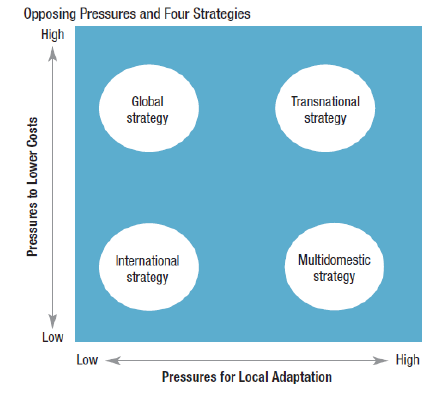Explain the following internationalisation strategies and identify TWO risks associated with each of the strategies: (12 marks)
i) International strategy
View Solution

International strategy
Explanation
Multinational companies that are confronted with low cost pressures and low pressures for local responsiveness pursue “International Strategy”. An international strategy is based on diffusion and adaptation of the parent company’s knowledge and expertise to foreign markets. Country units are allowed to make some minor adaptations to products and ideas coming from the head office, but they have far less independence and autonomy compared to multidomestic companies. The primary goal of the strategy is worldwide exploitation of the parent firm’s knowledge and capabilities. All sources of core competencies are centralized. This strategy type is ethnocentric since the foreign activities only secure the home-country company. A strong dependence of the foreign subsidiary on the resources of the home country is a consequence.
Risks associated with international strategy
i. Different activities in the value chain typically have different optimal locations. The international strategy, with its tendency to concentrate most of its activities in one location, fails to take advantage of the benefits of an optimally distributed value chain.
ii. The lack of local responsiveness may result in the alienation of local customers.
iii. The firm’s inability to be receptive to new ideas and innovation from its foreign subsidiaries may lead to missed opportunities.
ii) Global strategy
View Solution
Explanation
The multinational companies facing low pressure for local adaptation and responsiveness but high pressure to lower cost pursue “Global Strategy”. Companies that pursue a global strategy focus on increasing profitability by reaping the cost reductions that come from economies of scale and location economies; that is, their business model is based on pursuing a low-cost strategy on a global scale. A global strategy emphasizes economies of scale due to the standardization of products and services, and the centralization of operations in a few locations. These companies try not to customize their product offerings and marketing strategy to local conditions because customization, which involves shorter production runs and the duplication of functions, can raise costs. Instead, they prefer to market a standardized product worldwide so that they can reap the maximum benefits from economies of scale.
Risks associated with Global strategy
i. A firm can enjoy scale economies only by concentrating scale-sensitive resources and activities in one or few locations. Such concentration, however, becomes a “double-edged sword.” Thus, decisions about locating facilities must weigh the potential benefits from concentrating operations in a single location against the higher transportation and tariff costs that result from such concentration.
ii. The geographic concentration of any activity may also tend to isolate that activity from the targeted markets. Such isolation may be risky since it may hamper the facility’s ability to quickly respond to changes in market conditions and needs.
iii. Concentrating an activity in a single location also makes the rest of the firm dependent on that location. Such dependency implies that, unless the location has world-class competencies, the firm’s competitive position can be eroded if problems arise.
iii) Multidomestic/Multinational strategy
View Solution
Explanation
Multidomestic strategy is the reverse of global strategy since the company faces high pressure for local responsiveness and adaptation but with low pressure to lower costs. A firm whose emphasis is on differentiating its product and service offerings to adapt to local markets follows a multidomestic strategy. Decisions evolving from a multidomestic strategy tend to be decentralized to permit the firm to tailor its products and respond rapidly to changes in demand. This enables a firm to expand its market and to charge different prices in different markets.
Risks associated with Multidomestic
i. Decreased ability to realize cost savings through scale economies.
ii. Greater difficulty in transferring knowledge across countries as a result of localization of core competences.
iii. May lead to “over adaptation” as conditions change. In many industry segments, a variety of factors, such as the influence of global media, greater international travel, and declining income disparities across countries, may lead to increasing global standardization.
iv) Transnational strategy
View Solution
Explanation
Transnational strategy is adopted by company that simultaneously faces both strong cost pressures and strong pressures for local responsiveness. In essence, companies that pursue a transnational strategy are trying to develop a business model that simultaneously achieves low costs, differentiates the product offering across geographic markets, and fosters a flow of skills between different subsidiaries in the company’s global network of operations. As attractive as this may sound, the strategy is not an easy one to pursue because it places conflicting demands on the company.
Risks associated with Transnational strategy
i. The choice of a seemingly optimal location cannot guarantee that the quality and cost of factor inputs (i.e., labor, materials) will be optimal. Managers must ensure that the relative advantage of a location is actually realized, not squandered because of weaknesses in productivity and the quality of internal operations.
ii. Although knowledge transfer can be a key source of competitive advantage, it does not take place “automatically.” For knowledge transfer to take place from one subsidiary to another, it is important for the source of the knowledge, the target units, and the corporate headquarters to recognize the potential value of such unique know-how.
